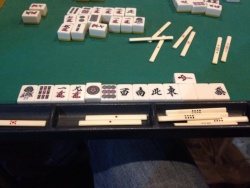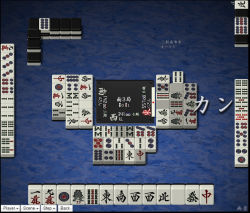Kokushi musou
| Type | Yakuman |
|---|---|
| Kanji |
国士無双 国士無双13面待ち |
| English | Thirteen orphans |
| Value | Yakuman (closed only) |
| Speed | Slow |
| Difficulty | Hard |
Kokushi musou 「国士無双」, also simply known as kokushi or in English as thirteen orphans, is one of the standard yakuman hands. It is one of the two exceptions of the "four tile groups and one pair" requirement for tenpai hands, where the other exception is chiitoitsu. Specifically, it involves 12 individual tiles and a pair.
Composition
Kokushi musou requires one of each terminal tile from each suit, and one of each of the honor tiles. The 14th tile must be a duplicate of any terminal or honor tile. These tiles are classed as yaochuuhai 「幺九牌」. Because the hand does not contain tile groups, the hand must be closed.
If a player draws the thirteen different tile types before pairing any of them, then the hand is called kokushi musou juusan menmachi 「国士無双13面待ち」, or the kokushi musou 13 closed wait. Some rulesets count this type of hand as a double yakuman.
Tile diagram
The hand requires nothing but yaochuuhai.
Kokushi musou single wait
Kokushi musou 13-way wait
![]()
![]()
![]()
![]()
![]()
![]()
![]()
![]()
![]()
![]()
![]()
![]()
![]() Winning tile: Any one of the tiles shown here
Winning tile: Any one of the tiles shown here
- Winning from this wait may be worth two yakuman in some rules.
Meaning and usage
The word kokushi can be translated as "distinguished citizen"; the word musou is often translated as "peerless". The word kokushi should not split up and expressed as "Koku shimusou". This is an incorrect spelling.
Development
Kokushi is one of the three yakuman gosanke 「役満御三家」, or "the three big families of yakuman", along with suuankou and daisangen. These are the three most common yakuman in the game (which are still rare).
Restricted as closed only, this hand must draw at least 12 of the 13 required tile types. If a pair exists within the hand upon tenpai, then naturally, the hand is waiting on the last remaining tile type not yet in the hand. This hand will become impossible if all four of any of the tile types are no longer available.
In order to reasonably develop this hand, your starting hand should contain many terminals, generally 9 or more. This gives the option to call kyuushu kyuuhai, if no tiles have been called, and if the ruleset allows. Declining (or not having) this option puts the hand on the path to form the yakuman.
Attempting kokushi

| Hand | Yaochuhai start | Discard at tenpai | Result | Lobby | Link |
|---|---|---|---|---|---|
| 東 2 局 1 本場 | 9 | 9th | Ron after 12th | 上級 | [1] |
| 東 2 局 1 本場 | 9 | 6th | Ron after 6th | 7447 | [2] |
| 南 3 局 0 本場 | 10 | 4th | Ron after 5th | 鳳凰 | [3] |
| 南 1 局 2 本場 | 8 | 15th | Haitei ron | 特上 | [4] |
| 南 4 局 0 本場 | 7 | 11th | Ron after 12th | 上級 | [5] |
| 南 2 局 0 本場 | 11 | 2nd | Ron after 2nd | 7447 | [6] |
| 東 2 局 1 本場 | 9 | 6th | Tsumo on 8th | 鳳凰 | [7] |
| Yaochuhai start includes the initial draw. | |||||
Any player attempting kokushi musou makes the decision at the beginning of the hand. This will depend on a couple of conditions, the most important being the number of unique yaochuhai at the start. The point standing and the current round also matter. Sometimes, players need a yakuman in order to win or improve placement.
- At 9 or less unique yaochuhai, the chance of winning, let alone the chance of reaching tenpai, are quite low. You should invoke a draw via kyuushu kyuuhai, if able, unless you really need a big hand.
- At 10 unique yaochuhai, it becomes more reasonable to go for the yakuman. Assuming you have a pair, the hand's ukeire is somewhat lower than a 2-shanten chiitoitsu. If you need a quick hand (e.g. to improve placing when close to all last), then a draw can be reasonable to invoke, if able.
- At 11 unique yaochuhai, the hand is basically at iishanten, so you should usually go for kokushi.
13-way wait development
Kokushi musou juusan menmachi is very rare. Out of all random tile draws that result in tenpai for kokushi, the chance of naturally drawing all 13 tiles without a single duplicate is approximately one in 9500 (~0.0106%). The only "consistent" way to achieve the double yakuman is to complete kokushi via tsumo, but discard the pair and hope to complete the hand while in furiten.
Kyuushu kyuuhai
Realistic chances to complete kokushi musou may require a hand to begin with at least 9 yaochuhai. Even so, at this point, this gives a player the option to defer and abort the hand, rather than trying for kokushi. If a tile has been called before your first turn, then kyuushu kyuuhai becomes unavailable. Also, some rulesets may disable the abortive draw.
Value
This hand is a yakuman hand. When dealer, the hand scores 48,000 points. For non-dealers, the hand scores 32,000.
Certain rulesets may grant a double yakuman for the 13-wait variety. Some require that the 13-sided wait is not in furiten to score a double yakuman; others allow a double yakuman no matter what.
Chankan rule variation

Under some rules, a kokushi tenpai hand may win via chankan off a closed kan made with the winning tile. When allowed, this is an exception to the usual rule that ron may be called off of the tile used to form an added kan, but not a closed kan. This rule, although not universal, is fairly common.
External links
- Kokushi musou in Japanese Wikipedia
- Osamuko.com entry on Kokushi
- 【麻雀】沢崎誠の国士無双13面張!! (YouTube)
- Kokushi 13, while furiten
| |||||||||||||||||||||||||||||||
| ||||||||||||||||||||||

